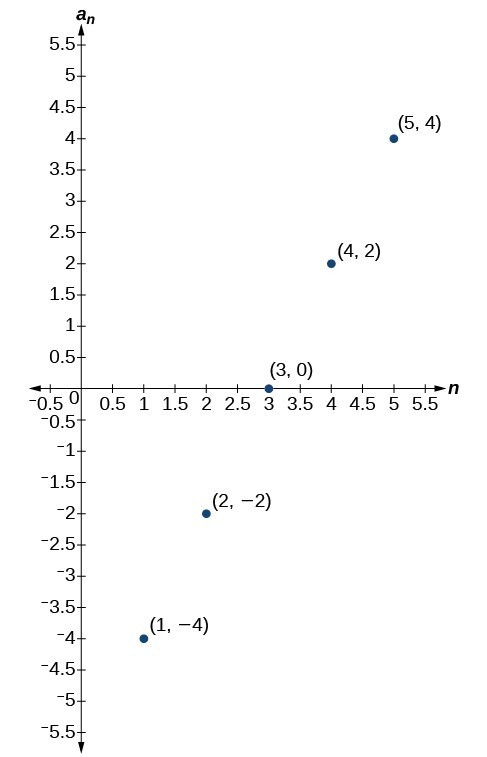Section Exercises
1. What is an arithmetic sequence?
2. How is the common difference of an arithmetic sequence found?
3. How do we determine whether a sequence is arithmetic?
4. What are the main differences between using a recursive formula and using an explicit formula to describe an arithmetic sequence?
5. Describe how linear functions and arithmetic sequences are similar. How are they different?
For the following exercises, find the common difference for the arithmetic sequence provided.
6. [latex]\left\{5,11,17,23,29,...\right\}[/latex]
7. [latex]\left\{0,\frac{1}{2},1,\frac{3}{2},2,...\right\}[/latex]
For the following exercises, determine whether the sequence is arithmetic. If so find the common difference.
8. [latex]\left\{11.4,9.3,7.2,5.1,3,...\right\}[/latex]
9. [latex]\left\{4,16,64,256,1024,...\right\}[/latex]
For the following exercises, write the first five terms of the arithmetic sequence given the first term and common difference.
10. [latex]{a}_{1}=-25[/latex] , [latex]d=-9[/latex]
11. [latex]{a}_{1}=0[/latex] , [latex]d=\frac{2}{3}[/latex]
For the following exercises, write the first five terms of the arithmetic series given two terms.
12. [latex]{a}_{1}=17,{a}_{7}=-31[/latex]
13. [latex]{a}_{13}=-60,{a}_{33}=-160[/latex]
For the following exercises, find the specified term for the arithmetic sequence given the first term and common difference.
14. First term is 3, common difference is 4, find the 5th term.
15. First term is 4, common difference is 5, find the 4th term.
16. First term is 5, common difference is 6, find the 8th term.
17. First term is 6, common difference is 7, find the 6th term.
18. First term is 7, common difference is 8, find the 7th term.
For the following exercises, find the first term given two terms from an arithmetic sequence.
19. Find the first term or [latex]{a}_{1}[/latex] of an arithmetic sequence if [latex]{a}_{6}=12[/latex] and [latex]{a}_{14}=28[/latex].
20. Find the first term or [latex]{a}_{1}[/latex] of an arithmetic sequence if [latex]{a}_{7}=21[/latex] and [latex]{a}_{15}=42[/latex].
21. Find the first term or [latex]{a}_{1}[/latex] of an arithmetic sequence if [latex]{a}_{8}=40[/latex] and [latex]{a}_{23}=115[/latex].
22. Find the first term or [latex]{a}_{1}[/latex] of an arithmetic sequence if [latex]{a}_{9}=54[/latex] and [latex]{a}_{17}=102[/latex].
23. Find the first term or [latex]{a}_{1}[/latex] of an arithmetic sequence if [latex]{a}_{11}=11[/latex] and [latex]{a}_{21}=16[/latex].
For the following exercises, find the specified term given two terms from an arithmetic sequence.
24. [latex]{a}_{1}=33[/latex] and [latex]{a}_{7}=-15[/latex]. Find [latex]{a}_{4}[/latex].
25. [latex]{a}_{3}=-17.1[/latex] and [latex]{a}_{10}=-15.7[/latex]. Find [latex]{a}_{21}[/latex].
For the following exercises, use the recursive formula to write the first five terms of the arithmetic sequence.
26. [latex]{a}_{1}=39;\text{ }{a}_{n}={a}_{n - 1}-3[/latex]
27. [latex]{a}_{1}=-19;\text{ }{a}_{n}={a}_{n - 1}-1.4[/latex]
For the following exercises, write a recursive formula for each arithmetic sequence.
28. [latex]{a}_{n}=\left\{40,60,80,...\right\}[/latex]
29. [latex]{a}_{n}=\left\{17,26,35,...\right\}[/latex]
30. [latex]{a}_{n}=\left\{-1,2,5,...\right\}[/latex]
31. [latex]{a}_{n}=\left\{12,17,22,...\right\}[/latex]
32. [latex]{a}_{n}=\left\{-15,-7,1,...\right\}[/latex]
33. [latex]{a}_{n}=\left\{8.9,10.3,11.7,...\right\}[/latex]
34. [latex]{a}_{n}=\left\{-0.52,-1.02,-1.52,...\right\}[/latex]
35. [latex]{a}_{n}=\left\{\frac{1}{5},\frac{9}{20},\frac{7}{10},...\right\}[/latex]
36. [latex]{a}_{n}=\left\{-\frac{1}{2},-\frac{5}{4},-2,...\right\}[/latex]
37. [latex]{a}_{n}=\left\{\frac{1}{6},-\frac{11}{12},-2,...\right\}[/latex]
For the following exercises, write a recursive formula for the given arithmetic sequence, and then find the specified term.
38. [latex]{a}_{n}=\left\{7\text{, }4\text{, }1\text{, }...\right\}[/latex]; Find the 17th term.
39. [latex]{a}_{n}=\left\{4\text{, }11\text{, }18\text{, }...\right\}[/latex]; Find the 14th term.
40. [latex]{a}_{n}=\left\{2\text{, }6\text{, }10\text{, }...\right\}[/latex]; Find the 12th term.
For the following exercises, use the explicit formula to write the first five terms of the arithmetic sequence.
41. [latex]{a}_{n}=24 - 4n[/latex]
42. [latex]{a}_{n}=\frac{1}{2}n-\frac{1}{2}[/latex]
For the following exercises, write an explicit formula for each arithmetic sequence.
43. [latex]{a}_{n}=\left\{3,5,7,...\right\}[/latex]
44. [latex]{a}_{n}=\left\{32,24,16,...\right\}[/latex]
45. [latex]{a}_{n}=\left\{-5\text{, }95\text{, }195\text{, }...\right\}[/latex]
46. [latex]{a}_{n}=\left\{-17\text{, }-217\text{, }-417\text{,}...\right\}[/latex]
47. [latex]{a}_{n}=\left\{1.8\text{, }3.6\text{, }5.4\text{, }...\right\}[/latex]
48. [latex]{a}_{n}=\left\{-18.1,-16.2,-14.3,...\right\}[/latex]
49. [latex]{a}_{n}=\left\{15.8,18.5,21.2,...\right\}[/latex]
50. [latex]{a}_{n}=\left\{\frac{1}{3},-\frac{4}{3},-3\text{, }...\right\}[/latex]
51. [latex]{a}_{n}=\left\{0,\frac{1}{3},\frac{2}{3},...\right\}[/latex]
52. [latex]{a}_{n}=\left\{-5,-\frac{10}{3},-\frac{5}{3},\dots \right\}[/latex]
For the following exercises, find the number of terms in the given finite arithmetic sequence.
53. [latex]{a}_{n}=\left\{3\text{,}-4\text{,}-11\text{, }...\text{,}-60\right\}[/latex]
54. [latex]{a}_{n}=\left\{1.2,1.4,1.6,...,3.8\right\}[/latex]
55. [latex]{a}_{n}=\left\{\frac{1}{2},2,\frac{7}{2},...,8\right\}[/latex]
For the following exercises, determine whether the graph shown represents an arithmetic sequence.
56.
 57.
57.
 For the following exercises, use the information provided to graph the first 5 terms of the arithmetic sequence.
58. [latex]{a}_{1}=0,d=4[/latex]
59. [latex]{a}_{1}=9;{a}_{n}={a}_{n - 1}-10[/latex]
60. [latex]{a}_{n}=-12+5n[/latex]
For the following exercises, follow the steps to work with the arithmetic sequence [latex]{a}_{n}=3n - 2[/latex] using a graphing calculator:
For the following exercises, use the information provided to graph the first 5 terms of the arithmetic sequence.
58. [latex]{a}_{1}=0,d=4[/latex]
59. [latex]{a}_{1}=9;{a}_{n}={a}_{n - 1}-10[/latex]
60. [latex]{a}_{n}=-12+5n[/latex]
For the following exercises, follow the steps to work with the arithmetic sequence [latex]{a}_{n}=3n - 2[/latex] using a graphing calculator:
- Press [MODE]
- Select SEQ in the fourth line
- Select DOT in the fifth line
- Press [ENTER]
- Press [Y=]
- [latex]n\text{Min}[/latex] is the first counting number for the sequence. Set [latex]n\text{Min}=1[/latex]
- [latex]u\left(n\right)[/latex] is the pattern for the sequence. Set [latex]u\left(n\right)=3n - 2[/latex]
- [latex]u\left(n\text{Min}\right)[/latex] is the first number in the sequence. Set [latex]u\left(n\text{Min}\right)=1[/latex]
- Press [2ND] then [WINDOW] to go to TBLSET
- Set [latex]\text{TblStart}=1[/latex]
- Set [latex]\Delta \text{Tbl}=1[/latex]
- Set Indpnt: Auto and Depend: Auto
- Press [2ND] then [GRAPH] to go to the TABLE
Licenses & Attributions
CC licensed content, Specific attribution
- Precalculus. Provided by: OpenStax Authored by: OpenStax College. Located at: https://cnx.org/contents/[email protected]:1/Preface. License: CC BY: Attribution.
